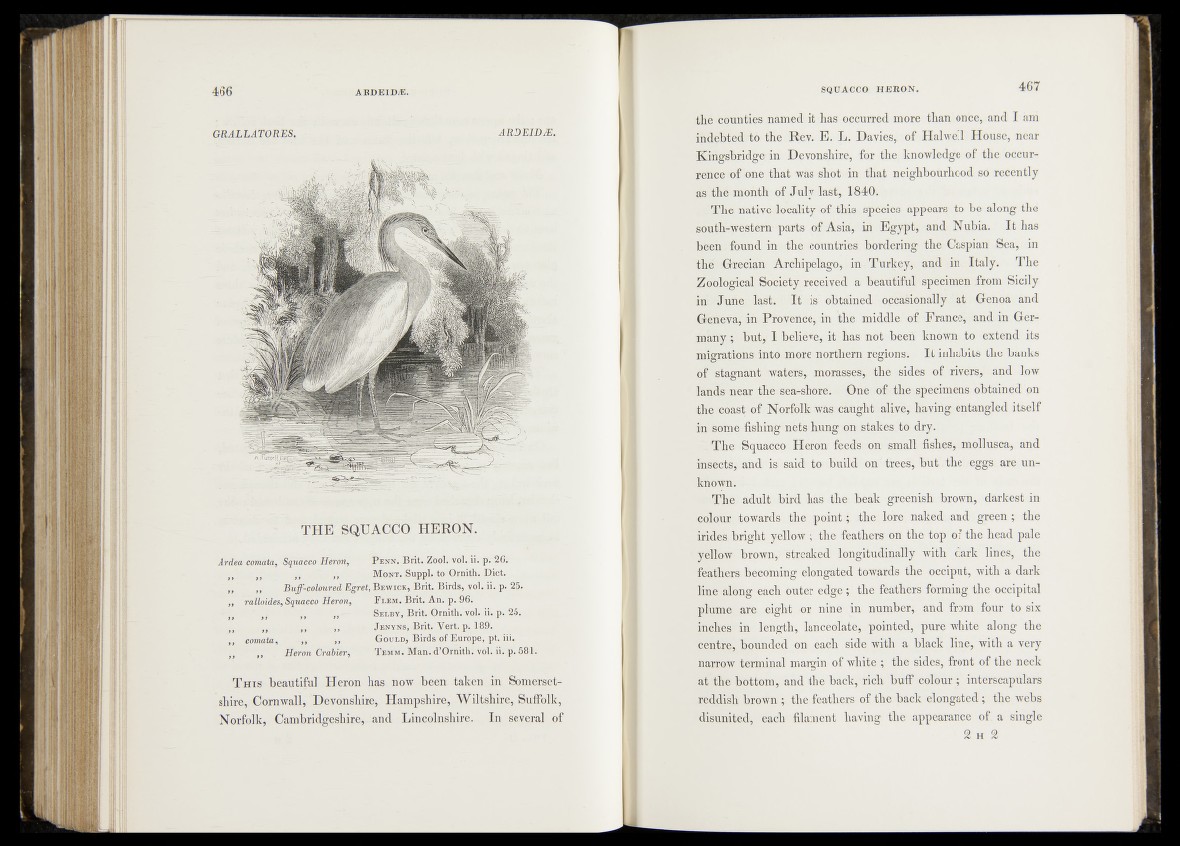
GRALLATORES. ARBEID IE.
T H E SQUACCO HERON,
Ardea comuta, Squacco Heron, P enn. Brit. ZoolB’ffllp .
j£l }) it t> Mont. Suppl. to.’Ornit^. Djct.^
~ „ „ Buff-coloured Egret, Bewick, Brit. Birds, vol,ii. p.J2§.
„ ralloides, Squacco Heron, Flem, Brit. An. p. 90.
v * ,t lf-~— Selby, Brit. Ornith. vol. i|*-gVg5.
.... . i, ,, i J en^ns,—Brit.‘^eit, ^ 1 8 9 ,^
„ comata, n „ Gould, Birds of Europe, pt. ii-I^
„ , Heron Grabler,' ’ P emm. Man. d’Ornith3f.Vol. ii. p. 581.
T h i s beautiful Heron lias now been- taken in Somersetshire,
Cornwall, Devonshire, Hampshire, Wiltshire, Suffolk,
Norfolk, Cambridgeshire,- and Lincolnshire. In several of
the counties named it has occurred more than once, and I am
indebted to the Rev. E. L. Davies, of Halwell House, near
Kingsbridge in Devonshire, for the knowledge of the occurrence
of bne that was shot in that neighbourhood so recently
as'the month of Julyfast^ 1840.
The native locality of this species appears to be along the
south-western parts of Asia, in Egypt, and Nubia. I t has
bfeeh; found in the countries bordering the Caspian Sea, in
the Grecian Archipelago, in Turkey,*;, and in Italy. The
Zoological Society.received a beautiful specimen from Sicily
in -June last. I t is obtained occasionally at Genoa and
Geneva,* in.-Provence, in the middle of France, and in Germany^
1 but, I believe, it has not been known to extend its
migrations into moré northern regions. I t inhabits the banks
of stagnant waters, morasses, the sides of rivers, and low
lands near the sea-shore. One ofxthe specimens obtained pn
the coast of Norfolk was caught alive, having entangled itself
in isome-fishing nfets hung on stakes to dry.
' The Squacco Heron feeds on small fishes, mollusca, and
insects, and is said to build on trees, shut. the eggs are urn
known.
: The adult bird has the beak greenish brown, darkest in
colour., towards the po in t; the lore naked and green ; the
irides bright yellow ; the feathers on the top of the head pale
yellow brown, streaked.;longitudinally with dark lines, the
feathers becoming elongated towards the occiput, with a dark
line along each outer edge; the feathers forming the occipital
plume are eight or nine in number, and from four to six
inches in length, lanceolate, pointed, pure white along the
centre, bounded on each side with a black line, with a very
narrow terminal margin of white ; the sides, front of the neck
at the bottom, and the back, rich buff colour ; interscapulars
reddish brown ; the feathers of the back elongated; the webs
disunited, each filament having the appearance of. a single
2 h 2